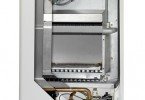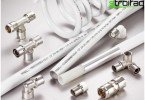Pipes for underfloor heating
The universal health formula that one should keep one’s head in the cold and one’s feet warm is well known to everyone and in practice is easily carried out in rooms heated by an ecologically clean water floor, the main working element of which is pipes for a warm floor. The concept of this method of space heating is to create in the space between the base and the finish floor of the pipeline network through which the coolant circulates. In the overwhelming majority of cases, the heat carrier is water heated to the optimum temperature, but ethylene glycol solution or antifreeze can be used..
Content
- Types of pipes for water floor heating
- PP pipes for underfloor heating
- XLPE pipes
- Metalloplastik – a set of priorities
- Copper is expensive but reliable
Types of pipes for water floor heating
The underfloor heating system evenly distributes heat in the room and has undeniable advantages compared to other heating methods, provided that the pipes are correctly selected and all components inherent in this heating system are calculated.
So, in order for the underfloor heating system to function smoothly for a long time, the pipe for a warm water floor must meet the following requirements:
- durability (optimal service life – at least 50 years);
- strength;
- environmental friendliness;
- memory effect or low linear expansion coefficient;
- minimum bending radius, contributing to the convenience of laying;
- high heat dissipation;
- soundproof.
When arranging modern floor water heating, the most popular are four types of pipes that meet, to a greater or lesser extent, all of the listed conditions, and divide them according to the material of manufacture:
- polypropylene;
- polyethylene;
- metal-plastic;
- copper.
Polypropylene pipes for underfloor heating
Polypropylene pipes for underfloor heating are less often used than others in the arrangement of floor water heating, despite the most affordable prices. Their main disadvantage is too large bending radius, equal to 8 diameters. For example, the corresponding indicator of polyethylene pipes is 5 diameters.
This means that with a diameter of 16 mm, a polypropylene pipe can be laid only with a minimum distance of 128 mm, which is not always enough to ensure the design heat output of the heating system. It also reduces the popularity of polypropylene pipes by limiting their installation temperature, which should not be lower than + 15 ° C, that is, the installation of pipes of this type in extreme climatic conditions, which differ in most Russian regions, is not recommended.
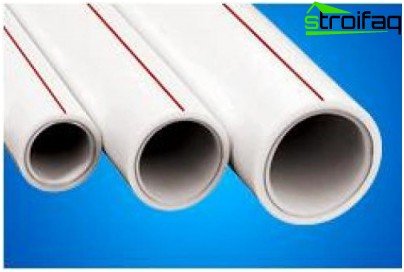
Polypropylene pipes are attractive in cost, but they have a large bend radius and the installation temperature is limited
XLPE pipes
Polyethylene, more precisely pipes made of cross-linked polyethylene, are durable, resistant to temperature influences, successfully combine decent quality and affordable prices. Their production uses a special technology of crosslinking: as a result of processing under high pressure in the polymer structure, in this case polyethylene, additional cross-links are formed, which ensure the strength and thermal stability of the finished products. Depending on the processing method of polyethylene, a material of different crosslinking densities is obtained: low (LDPE), medium (MDPE) and high (HDPE). For example, if ordinary pipes made of polyethylene in rare cases withstand prolonged temperature loads of 60 ° C, then their analogues made of cross-linked polyethylene are resistant to temperatures of 100-120 ° C, and their bending radius is 5 diameters. Their disadvantages:
- almost do not keep their shape when laying;
- probability of damage to the anti-diffusion layer during installation and pouring of concrete screed.
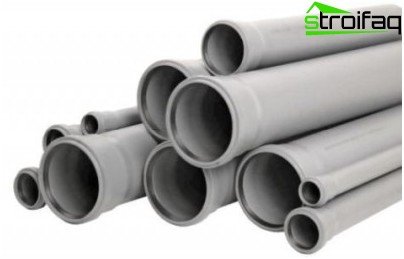
Pipes made of cross-linked polyethylene, are durable, resistant to temperature influences, successfully combine decent quality and affordable prices
Metalloplastik – a set of priorities
A metal-plastic pipe for a warm floor not only embodied the best properties of metal and polymer pipes, but also improved them. The result of symbiosis is a one-piece aluminum pipe with internal and external polymer protective layers. The inner polymer coating provides a perfectly smooth inner surface and corrosion protection: the pipe walls do not collapse, they are not covered with scale, and the pipe durability increases. External protective polymer coating protects aluminum from external damage. The metal-polymer pipe has the following 5-layer structure:
- polymer (polyethylene);
- bonding layer;
- aluminum pipe – one-piece, butt-welded or lap welded;
- bonding layer;
- polymer.
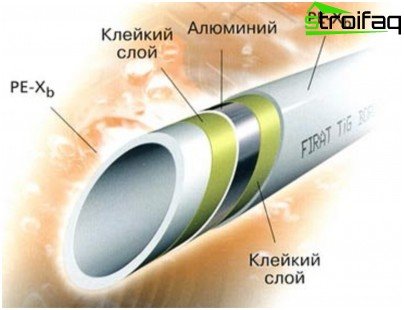
The metal-plastic pipe for a warm floor not only embodied the best properties of metal and polymer pipes, but also improved them
Plastic pipes from different manufacturers, mainly differ among themselves by the quality of the bonding composition. If, under the influence of high temperature, the elasticity of the adhesive decreases, the pipe delaminates. This defect can be detected by heating a pipe fragment to 100-120 ° C: if layers are visible in the section of the product, its quality does not meet the standards of floor heating. Among the disadvantages of plastic pipes, the following should be noted:
- cost, 20-30% higher than the cost of polymer pipes;
- tendency to creases in cases of exceeding the permissible bending radius.
Copper is expensive but reliable
A copper pipe for a warm floor is the best option that meets all the conditions for arranging floor heating and provides the highest level of reliability and quality. There is the only drawback that prevents the widespread use of copper pipes in floor heating systems – their high cost.
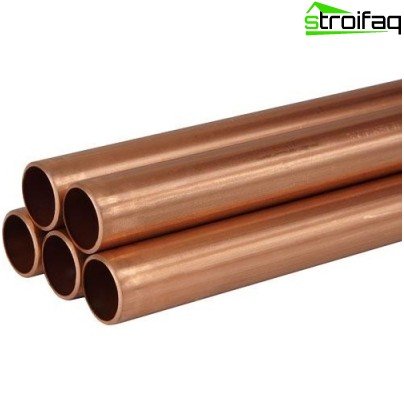
A copper pipe for a warm floor is the best option that meets all the conditions for arranging floor heating and provides the highest level of reliability and quality
How to calculate pipes for a warm floor
In the stern of the material of manufacture, the correct choice of pipe for a warm floor should take into account the pressure of the coolant in the riser of central heating or hot water and the area of the heated room. Depending on these values, the optimal pipe diameter is selected: for floor water heating, pipes with a diameter of 16, 20 or 25 mm are used. Installing a pipe of a smaller diameter than required in the construction of a warm floor often leads to disruption of water circulation in it. The water pressure in the riser can be measured independently by connecting a hydraulic pressure gauge to it, or find out in the technical department of house management.
The next value that determines the calculation of the pipe for a warm floor is its length. Getting to the calculations, it should be noted that the laying of the pipe system starts from the walls with windows, so that the hot heat carrier first heats the colder air, and then only evenly distributed throughout the system. In places where it is planned to install built-in or other bulky furniture, pipes are usually not laid.
To make the results more accurate, at this stage it is advisable to determine also how the pipes will be laid in the floor. The most popular today are two circuits of water floor heating: a snake (or zebra) and a shell (snail, spiral).
The “snake” circuit is widely used in Western Europe and attracts with its ease of calculation and installation. But this circuit does not provide uniform heat distribution and the effect of the “zebra” is manifested in significant temperature differences in individual sections of the floor, which correspond to the input and output of the circuits. At maximum operating conditions of the system, often on individual sections of the floor, the temperature may exceed the permissible value. The comfort level of the heating system decreases, heat losses increase. Laying pipes with a “snake” is justified in rooms with small heat losses and an amplitude of fluctuations in the water temperature at the inlet and outlet of about 5 ° C.
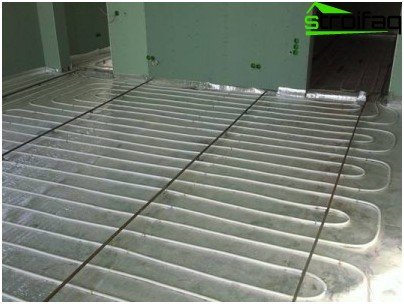
The “snake” pipe laying loop attracts with its ease of calculation and installation
The “snail” circuit is widespread in the CIS, despite the more complex design and installation features compared to the “snake”. The popularity of this method of laying pipes is due to the uniform distribution of heat over the entire heated floor surface, due to the alternation of parallel hot feeds and slightly cooled return pipes. In this underfloor heating design, the coolant return point is located exactly in the middle of the pipe length, and the average temperature is unchanged in any part of the floor.
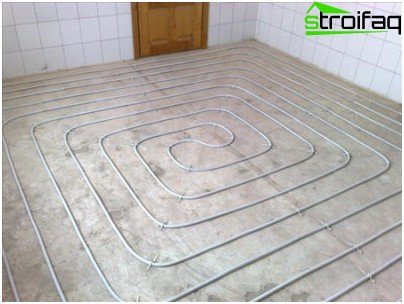
The “snail” pipe laying circuit ensures even heat distribution over the entire heated floor surface
Finally, you can proceed with the calculations. On a sheet of millimeter or any other paper in a cage, you need to draw a plan of the room taking into account the entrance group and windows in a scale of 1:50 and draw on it in scale the contour of the future warm floor, starting from the wall closest to the riser with windows. In accordance with the current building codes, warm floor pipes should be laid at a distance of 20-25 cm from the walls, and the pipe pitch depends on their diameter and is usually 35-50 cm. In the finished drawing, it is easy to measure the scale of the total length of the contour. Multiplying the resulting number by a scale factor of 50, we get the actual pipe length in meters, do not forget to add another 2 meters to connect the circuit to the riser.
Installation of pipes for floor water heating
Installation of underfloor heating begins with leveling the base with a special cement-based mortar. A layer of polymer vapor barrier and foil insulation are laid on the hardened surface to ensure the effect of a heat shield, glued at the joints with aluminum tape, and the excess is cut so that the edges come into the walls by 3-4 cm. Then, the underfloor heating pipes are laid in accordance with the drawing.
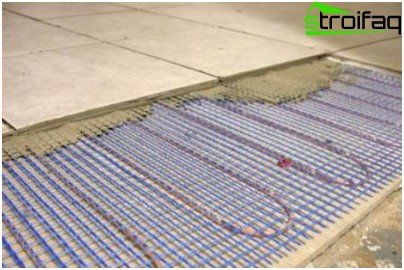
Stages of installation of the underfloor heating system: base, insulation, pipe laying, screed, finish flooring
It is recommended to bend pipes using a special mounting spring of the appropriate diameter: it is put on the pipe and does not allow it to bend. By bending pipes with your hands, it is difficult to accurately withstand the bending radius and avoid kinks.
The finished circuit is fixed with special plastic fasteners for the screed and connected to the riser. Fittings are installed at the inlet and outlet of the circuit pipe, having processed the connection with heat-resistant sealant, and then they are connected to the outlet and inlet of the riser, respectively. After completing the assembly and fastening of the underfloor heating circuit, fill the pipes with water and check the system for leaks, and then perform the screed and mount the finish coating.
Underfloor heating is excellent with floor tiles, linoleum and parquet. It is environmentally friendly and economical, and the efficiency and durability of a warm floor does not depend more on the cost and material of the pipes, but on the correct design and accurate implementation of the project..


